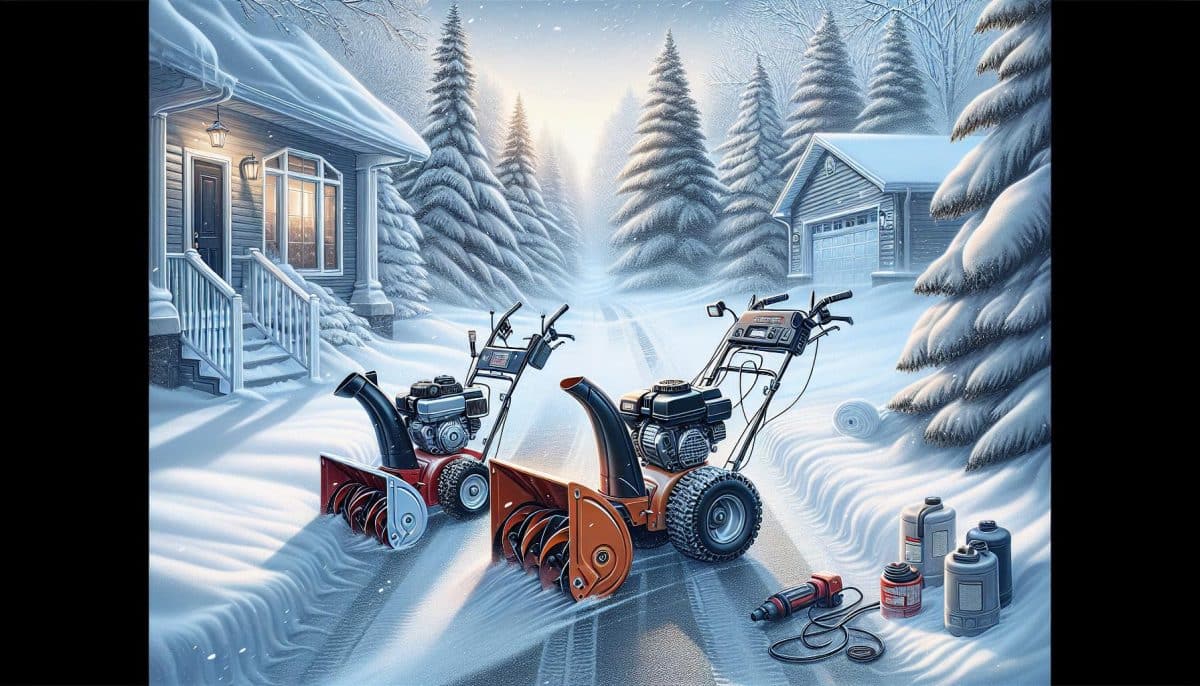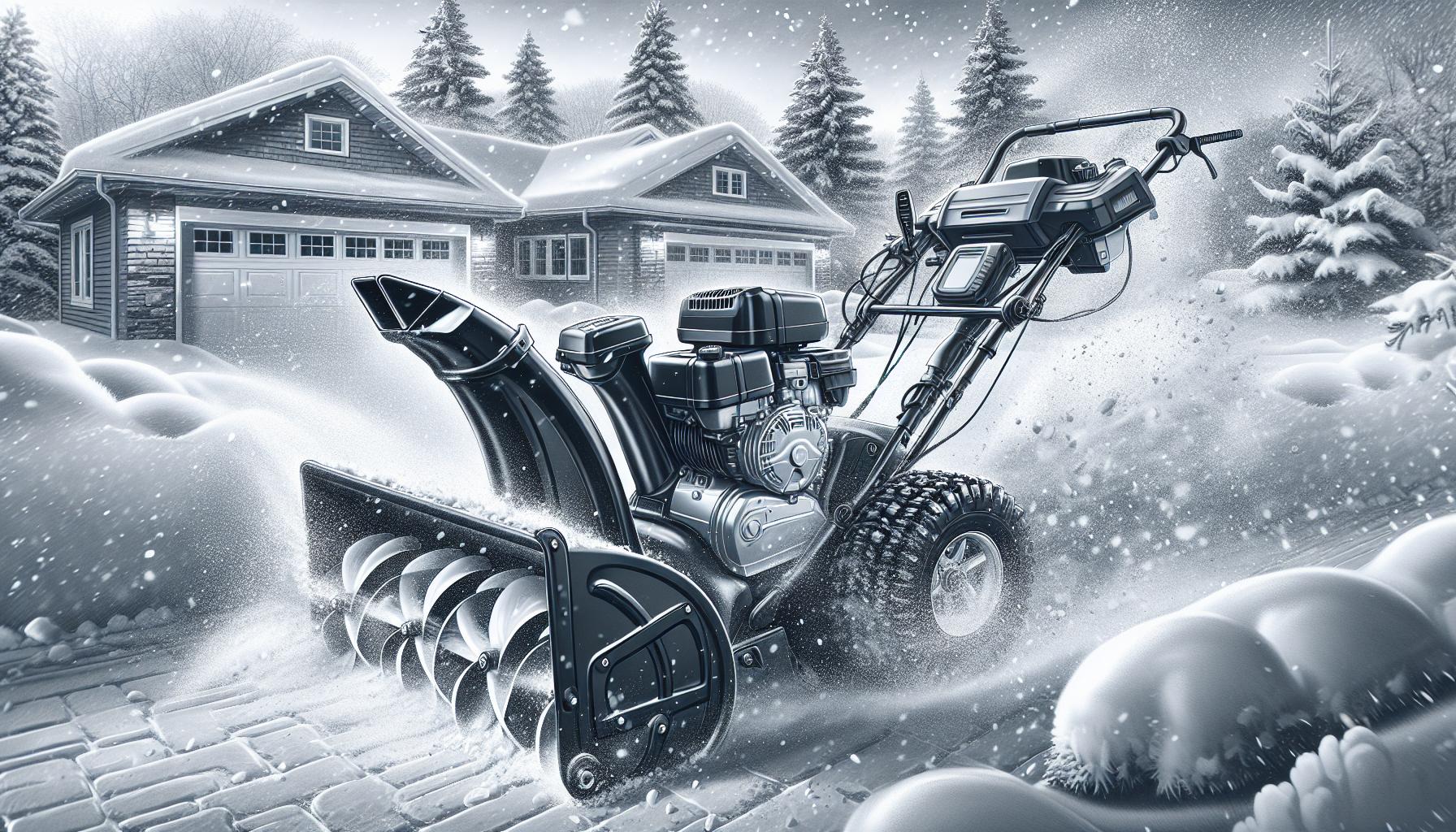
With gas prices soaring, you’re likely keeping a closer eye on your fuel consumption. While a snowblower may seem like a small player in your petrol budget, regular use can make its appetite for gas a real concern. Understanding how much gas your snowblower guzzles is key to managing winter expenses.
The gas usage of a snowblower isn’t one-size-fits-all; it varies based on several factors such as type, size, and operating conditions. On average, a 5-horsepower snowblower will consume about 0.5 gallons of fuel over 1-2.5 hours. It’s crucial to consider these details to estimate costs and ensure you’re not caught off-guard by a hefty fuel bill.
Factors Affecting Gas Consumption in Snowblowers
Engine Size
The engine size of a snowblower, usually measured in horsepower (HP), is a primary factor determining fuel consumption. Larger engines typically require more gas to operate. For instance, a snowblower with a 10 HP engine will consume twice the fuel of a 5 HP model, considering they’re run for the same duration. That’s due to the ratio of fuel use which is roughly 0.4 pounds per HP per hour. Understanding your snowblower’s engine size helps you estimate fuel expenses more accurately.
Snow Depth and Type
The type and depth of snow also significantly influence your snowblower’s gas consumption. Dense, wet snow requires your machine to work harder, using more gas in the process. Light, fluffy snow, but, is easier to move and so uses less fuel. As an example, clearing six inches of light snow could use considerably less fuel than clearing an equivalent area of heavy, compacted snow.
Clearing Width
Your snowblower’s clearing width impacts gas usage. Snowblowers with a wider clearing width cover more area with each pass, which can reduce the time and total gas needed. For instance, a model that clears 18 inches wide may use less gas overall than one with a 12-inch width because it accomplishes the task quicker, provided the snow type and depth are constant.
Operating Speed
Finally, the operating speed plays a role in fuel efficiency. Running your snowblower at full throttle will increase fuel consumption. Conversely, using a moderate speed tailored to the snow conditions can save gas. Ideally, you’ll want to find a balance between efficient snow clearing and optimal fuel usage. Faster isn’t always better, particularly if it leads to repeatedly covering the same area due to inefficient clearing.
Calculating Gas Consumption

When you’re making the most of your snowblower during the colder months, it’s essential to understand how much fuel you’ll be using. Let’s look into the factors that determine gas consumption and how you can calculate it effectively.
Recording Run-Time
Keeping track of how long your snowblower is running is fundamental to calculating gas consumption. Record the time from the moment you start the engine until you turn it off. This will give you an accurate measure of the machine’s run-time. Whether you’re clearing a light dusting or a heavy downfall, noting the elapsed time during each session is key. Remember, the longer the run-time, the greater the fuel consumption.
Measuring Fuel Efficiency
Fuel efficiency is gauged by the amount of gas used per hour of operation. Given that snowblowers use approximately 0.4 lb of fuel per horsepower per hour, you can estimate your snowblower’s efficiency. For a machine with 5 HP, you’re looking at using around 2 lbs of fuel per hour. With the average fuel tank size and the weight of the gasoline, work out the efficiency by dividing the total weight of gas by the rate of consumption.
Estimating Total Gas Consumption
Understanding your snowblower’s fuel consumption isn’t just about keeping your paths clear; it also involves managing costs and ensuring you’ve got enough fuel for the job. To estimate total gas consumption, consider the horsepower, fuel tank capacity, and your recording of run-time.
Use the established formula:
- 0.4 lb of fuel / HP / hr
A 14.5 HP snowblower using 0.8 gallons (5.2 lbs) of fuel will consume about 5.8 lbs of gasoline per hour. For continuous operation, simply multiply the consumption rate by the recorded run-time.
Let’s break down the average consumption into an accessible table for clarity:
| Snowblower Horsepower | Fuel Consumption Rate (lbs/hr) | Run-Time (hours) | Total Gas Consumption (lbs) |
|---|---|---|---|
| 5 HP | 2 | 1.5 – 2.5 | 3 – 5 |
| 14.5 HP | 5.8 | 1 | 5.8 |
Your snowblower’s gas usage will be dictated by these values and how you manage the runtime in different snow conditions. Keep in mind that actual gas consumption can vary based on additional factors such as snow type and blower efficiency. Armed with these calculations, you’re better equipped to manage your snow removal tasks without the worry of unexpectedly running out of gas.
Tips for Reducing Gas Consumption

When it comes to snowblower operation, efficient use of gas not only saves you money but also benefits the environment. Follow these tips to keep your machine running smoothly and your gas consumption in check.
Regular Maintenance
Regular maintenance is key to ensuring your snowblower uses gas efficiently. A well-maintained machine works more effectively, reducing the effort needed to clear snow, so conserving fuel. Here’s what you need to keep an eye on:
- Spark plugs: Ensure they are clean and functioning properly.
- Air filters: Replace or clean air filters regularly to improve fuel combustion.
- Oil changes: Perform oil changes according to the schedule in your user’s manual; fresh oil reduces engine friction.
- Carburetor: Keep it clean to prevent fuel blockages and improve engine efficiency.
Proper Use of Choke
Using the choke properly can also help to reduce gas usage. The choke aids in starting a cold engine by enriching the fuel mixture. To use it correctly:
- Engage the choke fully when starting a cold engine.
- Once the engine runs, gradually move to half choke.
- Allow the engine to warm up before turning the choke off completely.
- Running the snowblower on full choke for too long wastes fuel and can lead to engine flooding.
Adjusting Throttle Settings
The throttle controls the engine speed and, so, the fuel consumption rate. Adjust the throttle setting as follows:
- Set to high when starting or working through heavy snow.
- Once the engine is warmed up, lower the throttle to meet the demands of the task; avoid running on high throttle unnecessarily.
- A balanced throttle setting maintains efficient fuel use while providing sufficient power to clear snow effectively.
Clearing Snow Efficiently
The technique you use to clear snow can also impact gas consumption:
- Plan your route: Clear snow in a pattern that minimises overlap and double work.
- Snow depth: Adjust the forward speed of your snowblower to match the depth of snow—slower for deep, dense snow, and faster for lighter coverage.
- Keep It steady: Maintain a consistent pace for even fuel usage.
By implementing these strategies, you’ll not only extend the life of your snowblower but also cut down on gas costs. Regular upkeep paired with optimal operation techniques ensures your machine runs efficiently through each snow season.
Comparison: Gas vs Electric Snowblowers

Cost of Operation
When you’re looking to maintain your property during the winter months, the cost of operation is a key factor in choosing between gas and electric snowblowers. Electric snowblowers are generally cheaper to operate. There’s no need for gas, which means you’ll sidestep the ongoing expense of fuel and the associated costs of dealing with fuel-related maintenance issues.
In contrast, gas snowblowers require regular fuel purchases and maintenance. On average, a gas snowblower consumes about 0.4 pounds of fuel per horsepower per hour, which can add up over time, especially with rising fuel prices. Here’s a quick breakdown of the typical fuel consumption of gas snowblowers:
| Horsepower (HP) | Fuel Usage Per Hour (lbs) |
|---|---|
| 5 HP | 2 lbs |
| 7 HP | 2.8 lbs |
Remember, the initial cost of a gas snowblower might be higher if it’s more fuel-efficient, but reducing fuel usage can lead to long-term savings.
Environmental Impact
If environmental considerations influence your decisions, you’ll find electric snowblowers have a distinct advantage. They produce zero emissions during operation, which is a stark contrast to their gas-powered counterparts that emit pollutants linked to respiratory problems and environmental degradation.
Gas snowblowers not only contribute to air pollution but can also experience fuel leaks, leading to soil and water contamination. Considering that ethanol-blended fuels deteriorate quickly and can clog fuel systems, the potential for environmental harm increases with improper fuel storage and maintenance.
Electric snowblowers help reduce your carbon footprint, making them a more environmentally friendly option for eco-conscious individuals.
Power and Performance
Gas snowblowers boast powerful engines capable of moving large volumes of snow quickly, which can save you time in harsh weather conditions. They excel in areas that receive heavy snowfall, as they offer superior horsepower and torque compared to electric models.
Electric snowblowers, on the other hand, are quieter and lighter, making them more maneuverable and less disruptive. They may lack the raw power of gas models but are ideal for light to moderate snow conditions. They offer consistent performance with the simple push of a button – no need for pull starts or choke adjustments.
Here’s a performance comparison:
| Type | Best For | Maintenance | Noise Level |
|---|---|---|---|
| Gas Snowblowers | Heavy snowfall, large areas | High | Higher |
| Electric Snowblowers | Light to moderate snowfall, smaller areas | Low | Lower |
Each type of snowblower has its merits, and your choice will depend on your specific needs, whether it’s power and performance or ease of operation and environmental impact.
Conclusion
Understanding your snow removal needs is key to deciding between a gas and an electric snowblower. You’ve learned that while gas models are powerful and suited for heavier tasks, they do come with ongoing fuel costs and maintenance. On the other hand, electric snowblowers offer cost savings and environmental benefits but are best for lighter snowfall. Assess your situation, consider the trade-offs, and you’ll make an informed choice that aligns with your preferences for performance, convenience, and sustainability. Remember, the right snowblower for you is one that meets your demands while aligning with your values and budget.
Colin Macmillan is a seasoned entrepreneur and the CEO of Riverwood Landscape, a leading landscaping company based in Canada. He has been at the helm of the company since leaving high school, demonstrating his strong leadership skills and business acumen.
Colin’s expertise lies in various aspects of landscaping, including lawn care, interlocking, sod installation, and commercial maintenance. His hands-on approach and dedication to the craft have been instrumental in building Riverwood Landscape into a reputable brand.
One of his most notable achievements is the creation of a successful landscape franchise that services multiple locations. This accomplishment underscores his strategic thinking and ability to scale operations effectively.
Colin has also had the privilege of working with Guelph Hospital for landscaping and maintenance, a testament to the trust and reliability that his company has earned over the years.
His professional mission is to offer the best services and experiences for customers, a goal that he tirelessly pursues. Colin’s commitment to excellence and customer satisfaction continues to drive the growth and success of Riverwood Landscape.








